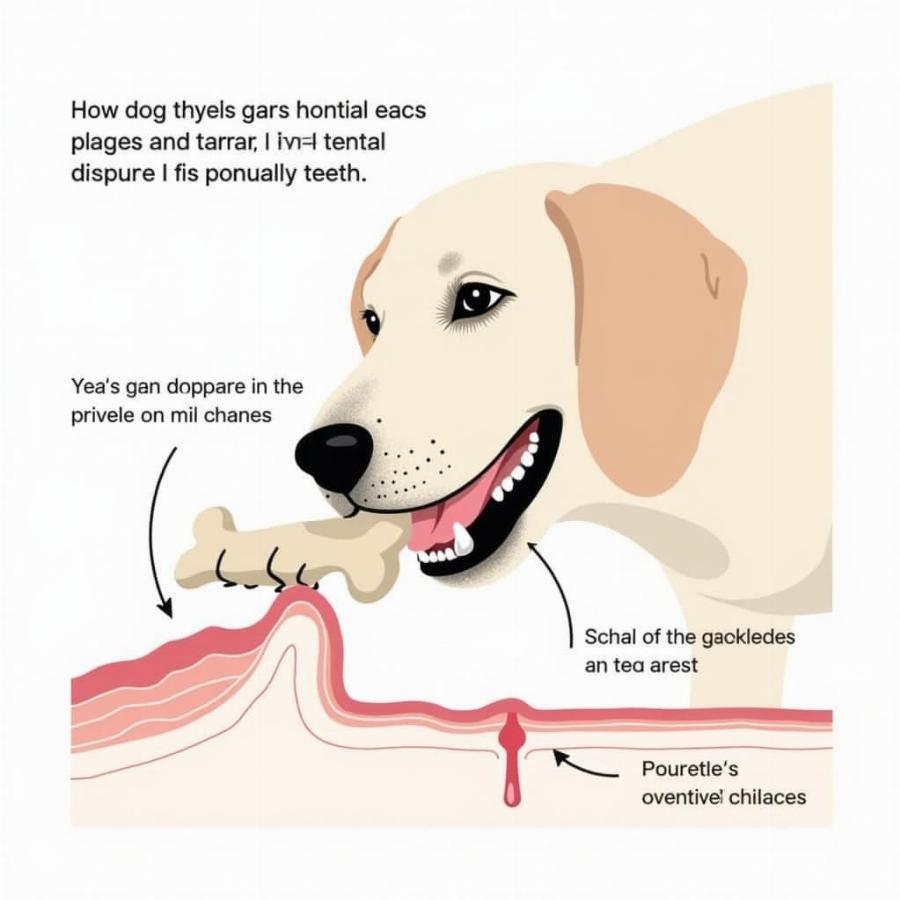Dogs and bones. It’s a classic pairing, isn’t it? But have you ever stopped to wonder why dogs have such an innate love for gnawing on bones? It goes deeper than just a simple doggy treat. Chewing on bones fulfills a range of physical, emotional, and instinctual needs for our canine companions. Let’s delve into the science and psychology behind this age-old canine behavior.
The Primal Instinct: Why Dogs Chew Bones
Dogs are descended from wolves, and while they’ve evolved considerably, certain instincts remain deeply ingrained. For wolves, chewing on bones was essential for survival – it provided vital nutrients, cleaned their teeth, and strengthened their jaws. This instinctual drive to chew persists in domestic dogs, even though their kibble-filled bowls ensure they’re well-nourished. Chewing offers them a connection to their wild ancestors, fulfilling a deep-seated need.
Dental Benefits: Bones as Nature’s Toothbrush
 Chó chăm sóc răng miệng
Chó chăm sóc răng miệng
Just like us, dogs can suffer from dental problems. Chewing on bones acts as a natural toothbrush, scraping away plaque and tartar buildup. This helps prevent bad breath, gum disease, and other dental issues. It’s a much more engaging form of dental hygiene than a toothbrush, wouldn’t you say?
Stress Relief and Mental Stimulation: The Soothing Power of Chewing
Does your dog ever seem anxious or bored? Chewing can be a wonderfully calming activity for them. The repetitive motion of gnawing on a bone releases endorphins, which have mood-boosting and pain-relieving properties. This makes chewing a great way for dogs to self-soothe and cope with stress. Think of it as their version of a stress ball!
Nutritional Value: More Than Just a Chew Toy
While most commercially produced dog food provides complete nutrition, bones can still offer some nutritional benefits. Many bones contain marrow, a rich source of essential fatty acids and vitamins. However, it’s important to note that not all bones are safe for dogs. Cooked bones, especially cooked poultry bones, can splinter and cause serious internal injuries. Always opt for raw, recreational bones specifically designed for dogs.
What Kind of Bones Are Safe for Dogs?
Raw beef, lamb, or bison bones are generally safe options. Avoid giving your dog pork bones or any cooked bones. Always supervise your dog when they’re chewing on a bone and discard it when it becomes small enough to be swallowed.
Jaw Strength and Muscle Development: A Workout for the Mouth
Chewing on bones is a great way for dogs to exercise their jaw muscles and maintain their bite strength. This is particularly important for puppies who are still developing their jaw muscles. Imagine it as their daily gym session for their mouth!
Do Dogs Chew Bones Out of Boredom?
Sometimes, excessive chewing can be a sign of boredom. If your dog is chewing on everything in sight, including things they shouldn’t, it might be time to increase their physical activity and mental stimulation. Provide them with plenty of toys, puzzles, and opportunities for playtime. best dog teething toys might be helpful if your dog is a puppy.
How Can I Tell if My Dog Is Chewing Excessively?
If your dog is destroying furniture, shoes, or other household items, they’re likely chewing excessively. This is a sign that they need more outlets for their energy and chewing instinct.
Conclusion: The Many Benefits of Bone Chewing
Chewing on bones is a natural and beneficial activity for dogs, satisfying their primal instincts, promoting dental health, relieving stress, and providing mental stimulation. By understanding why dogs love to chew, we can provide them with safe and appropriate chewing outlets, ensuring their overall health and well-being.
FAQ:
- Are all bones safe for dogs? No, cooked bones, especially poultry bones, can splinter and cause internal injuries. Stick to raw, recreational bones designed for dogs.
- What if my dog swallows a bone splinter? Contact your veterinarian immediately if you suspect your dog has swallowed a bone splinter.
- Can puppies chew on bones? Yes, puppies can chew on bones, but they should be supervised and given appropriately sized bones.
- What are some alternatives to bones for chewing? There are many safe and durable chew toys available, such as rubber toys, nylon bones, and rope toys.
- How can I prevent my dog from chewing on furniture? Provide your dog with plenty of appropriate chew toys and ensure they get enough exercise and mental stimulation.
- Why does my dog hide their bones? This is a natural instinct, stemming from their ancestral need to protect their resources.
- What should I do if my dog guards their bone aggressively? Consult with a professional dog trainer or behaviorist to address resource guarding issues.
Beaut Dogs is your go-to resource for all things related to dog care, providing expert advice and guidance on choosing the right breed, nutrition, training, and health. For personalized support and answers to your specific questions, reach out to us via Email at [email protected]. Beaut Dogs is committed to helping you provide the best possible care for your beloved canine companion. We encourage you to explore our other helpful articles, such as fenway hot dog for more interesting insights.